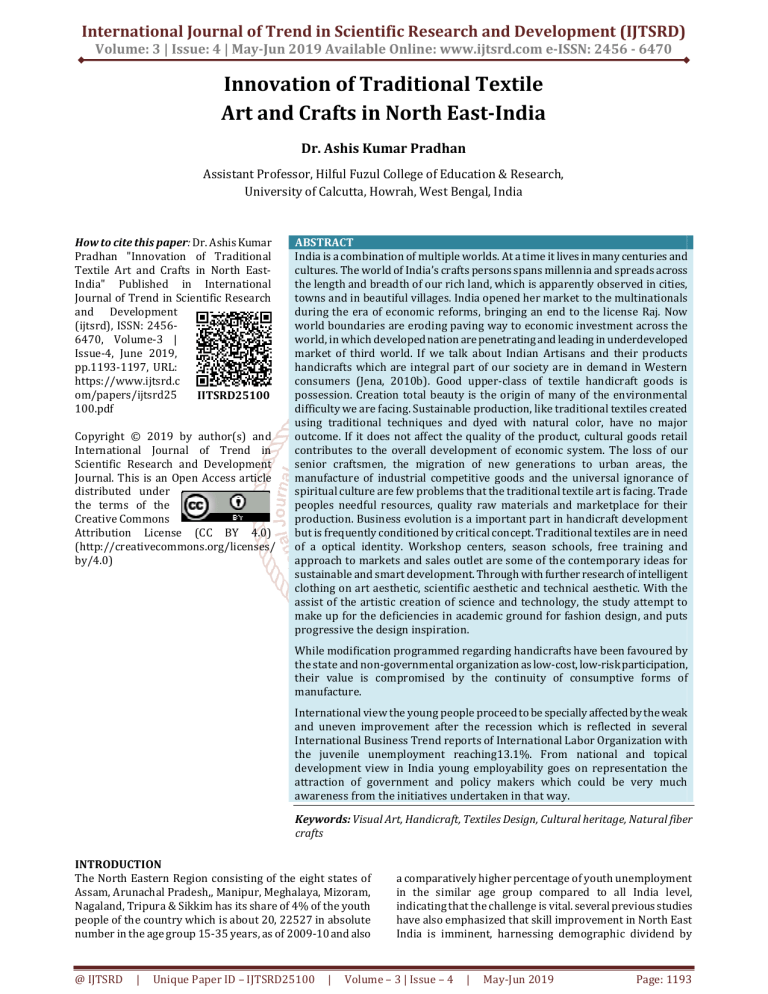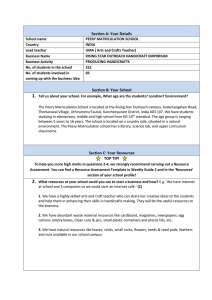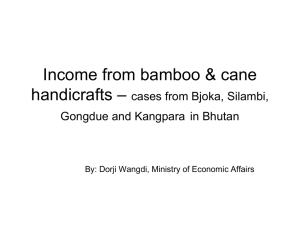
International Journal of Trend in Scientific Research and Development (IJTSRD) Volume: 3 | Issue: 4 | May-Jun 2019 Available Online: www.ijtsrd.com e-ISSN: 2456 - 6470 Innovation of Traditional Textile Art and Crafts in North East-India Dr. Ashis Kumar Pradhan Assistant Professor, Hilful Fuzul College of Education & Research, University of Calcutta, Howrah, West Bengal, India How to cite this paper: Dr. Ashis Kumar Pradhan "Innovation of Traditional Textile Art and Crafts in North EastIndia" Published in International Journal of Trend in Scientific Research and Development (ijtsrd), ISSN: 24566470, Volume-3 | Issue-4, June 2019, pp.1193-1197, URL: https://www.ijtsrd.c om/papers/ijtsrd25 IJTSRD25100 100.pdf Copyright © 2019 by author(s) and International Journal of Trend in Scientific Research and Development Journal. This is an Open Access article distributed under the terms of the Creative Commons Attribution License (CC BY 4.0) (http://creativecommons.org/licenses/ by/4.0) ABSTRACT India is a combination of multiple worlds. At a time it lives in many centuries and cultures. The world of India’s crafts persons spans millennia and spreads across the length and breadth of our rich land, which is apparently observed in cities, towns and in beautiful villages. India opened her market to the multinationals during the era of economic reforms, bringing an end to the license Raj. Now world boundaries are eroding paving way to economic investment across the world, in which developed nation are penetrating and leading in underdeveloped market of third world. If we talk about Indian Artisans and their products handicrafts which are integral part of our society are in demand in Western consumers (Jena, 2010b). Good upper-class of textile handicraft goods is possession. Creation total beauty is the origin of many of the environmental difficulty we are facing. Sustainable production, like traditional textiles created using traditional techniques and dyed with natural color, have no major outcome. If it does not affect the quality of the product, cultural goods retail contributes to the overall development of economic system. The loss of our senior craftsmen, the migration of new generations to urban areas, the manufacture of industrial competitive goods and the universal ignorance of spiritual culture are few problems that the traditional textile art is facing. Trade peoples needful resources, quality raw materials and marketplace for their production. Business evolution is a important part in handicraft development but is frequently conditioned by critical concept. Traditional textiles are in need of a optical identity. Workshop centers, season schools, free training and approach to markets and sales outlet are some of the contemporary ideas for sustainable and smart development. Through with further research of intelligent clothing on art aesthetic, scientific aesthetic and technical aesthetic. With the assist of the artistic creation of science and technology, the study attempt to make up for the deficiencies in academic ground for fashion design, and puts progressive the design inspiration. While modification programmed regarding handicrafts have been favoured by the state and non-governmental organization as low-cost, low-risk participation, their value is compromised by the continuity of consumptive forms of manufacture. International view the young people proceed to be specially affected by the weak and uneven improvement after the recession which is reflected in several International Business Trend reports of International Labor Organization with the juvenile unemployment reaching13.1%. From national and topical development view in India young employability goes on representation the attraction of government and policy makers which could be very much awareness from the initiatives undertaken in that way. Keywords: Visual Art, Handicraft, Textiles Design, Cultural heritage, Natural fiber crafts INTRODUCTION The North Eastern Region consisting of the eight states of Assam, Arunachal Pradesh,, Manipur, Meghalaya, Mizoram, Nagaland, Tripura & Sikkim has its share of 4% of the youth people of the country which is about 20, 22527 in absolute number in the age group 15-35 years, as of 2009-10 and also @ IJTSRD | Unique Paper ID – IJTSRD25100 | a comparatively higher percentage of youth unemployment in the similar age group compared to all India level, indicating that the challenge is vital. several previous studies have also emphasized that skill improvement in North East India is imminent, harnessing demographic dividend by Volume – 3 | Issue – 4 | May-Jun 2019 Page: 1193 International Journal of Trend in Scientific Research and Development (IJTSRD) @ www.ijtsrd.com eISSN: 2456-6470 providing employable skills to the adolescence for enhancing employability is a chief mission to the lead in the improvement standard of NER. This study argues that state governments in the region need to expedite the skill development activities in tandem with the national initiatives proactively linking social partners in the area towards providing employable skills to the adolescence. In this view the study attempts to recognize the issues and suggests measures to tackle the issues in a broader perspective. The study emphasizes the require for focusing women workers skill development and employability issues and highlights a quantity of excellent practices in other economic development model which could be calculated additional to assume. Traditional crafts are labeled as: “folk art”, “local art”, “and green art”. This label frequently reply traveler’s quest for “the other” and has generous impact on those who create purpose of cultural value. The term handicraft is ambiguous. We do not really understand if we’re talking about an authentic work of art or a suggestive work in a preindustrial civilization framework. Art perception is altering very rapidly. Craft is still art when it no longer represents the viewpoint of a group but rather that of an individual. Throughout the process of creation authenticity, uniqueness and experience are key factors. Some art demonstrates no or little skills at using resources, but expresses something really thoughtful. Equally, some that we describe as craft expresses nothing in particular, but demonstrates enormous talent. However, a quantity of great art exhibit equally; great skills at using the resources selected, and expressing amazing profound. An attempt to identify something or someone as art or craft is thus meaningless. Besides the marketable value these products have also a representative meaning, often more significant than the utility or educational purpose. Handicrafts are the mark of a group of people, individual works of art reflecting a group. Cultural products are derived from distinctive characteristics of social groups: material, intellectual, spiritual and emotional characteristics. These fundamentals of artistic inheritance developed by individuals replicate the cultural artistic appearance of the society, either in a verbal or an objects form. Often traditional arts or handicrafts do not obtain the correct concentration. In a world of genuine time information the media does not cover subjects that escape moment. Crafts become the work of “slow media”, of programs that address a small cluster of community. It is a social structure, a means of production, and work of art, a social group and material framework for representation. The greater part of exporters and producers deliberate their energy on mechanized methods that ensure a fast and cheap production. Craftsmen feel that their art is not respected anymore and a small number of young craftsmen accept the challenge of effect ritual. The stasis of traditional drawing in motifs that have changed very little more time does not encourage young craftsmen, who feel limited in established sample. That is why the resolution might come from the close very cooperative between designers with craftsman’s. Assam Present Arts and crafts industries in Assam, Craft on Jute Diversification, Bell Metal Manufacture of Sarthebari. Brass metal, Fireworks, Craft in Barpeta, Bamboo, Cane, Sitalpati Craft, Masks Craft, Areca Nut Leaf. @ IJTSRD | Unique Paper ID - IJTSRD25100 | Fig-1.Handloom Products Fig-2.Cane & Bamboo Crafts Fig-3 Assamese Paintings Fig-4.Assamese Masks Arunachal Pradesh Arunachal Pradesh is a land of good-looking handicrafts consists of a wide beauty. Inventive craftsmanship has been approved on from one contemporary to the other. A wide variety of crafts such as weaving, smithy work, basketry painting, pottery, and wood carving flourish. Fig-5. Weaving Fig-7.bamboowork Fig-6.carpetmaking Fig-8 pottrery Manipur Various categories of Manipur handicrafts, Natural fiber crafts, Block print, Kauna Crafts, Cane and bamboo crafts, Woodcarving, terracotta, Black pottery, Ceramic pottery, Textile Weaving (Hand embroidered). Volume – 3 | Issue – 4 | May-Jun 2019 Page: 1194 International Journal of Trend in Scientific Research and Development (IJTSRD) @ www.ijtsrd.com eISSN: 2456-6470 Fig-9.Cane and bamboo crafts Fig-10. Kauna Crafts Fig-17 mizoram-pottery Nagaland Tribal of Nagaland are skillful at crafting different art works. Pottery in Nagaland, Wood Carving in Nagaland, Weaving in Nagaland, Basketry in Nagaland, Metal Work of Nagaland. Fig-11. Pottery, Black pottery Fig-12 Textile Weaving Meghalaya Meghalaya is domestic to many fantastic handicrafts. Weaving is it on textile or cane has been an art for extended in the circumstances. There are some wonderful handicrafts weaved by the different tribes of Meghalaya. A different famous work here includes woodcarving and bamboo work because the raw material for these products is originate in great quantity in the position. State produces a few wonderful baskets, caps, winnowing fans, umbrellas, stools, furthermore cane mats. Fig-13.bamboo- crafts-meghalaya Fig-18. Bamboo Baskets Fig-14.Meghalaya handicrafts Fig-19. Woodcarving Fig-15. Meghalaya weaving Mizoram, Special type of Mizoram handicraft: Basketry, Weaving, Shawls, Bamboo with cane product. Fig-16. canewood-furnniturebaskets-natural-fibers-straws @ IJTSRD | Unique Paper ID - IJTSRD25100 | Fig-20. Metal Work Tripura Tripura has imprinted out a name for itself in the ground of Handicrafts. The talented artisans create wonderful objects of crafts from simple material like wood, cane & bamboo. Volume – 3 | Issue – 4 | May-Jun 2019 Page: 1195 International Journal of Trend in Scientific Research and Development (IJTSRD) @ www.ijtsrd.com eISSN: 2456-6470 Fig-21. cane, bamboo & wood Sikkim Top-grade Traditional Handicrafts of Sikkim, 1. Carpets of Sikkim, 2. Wood Carving, 3. Thangka Painting, 4. Choktse Tables, 5. Handlooms. Conclusion Urbanized countries were artistic with natural resources and with very skilled technologies and skilled workers. Their infrastructures were highly urbanized and unique with those of developing country. On the other hand particularly India is land of traditional crafts and artisans, who are stick to their original skill. Their products are designed for rural and domestic markets and to maintain their profits. PostIndependence idea was taken in numerous five year plans for up gradations of technologies and training programmes were initiated. In these lessons, the result indicated a very low level of development and executive innovations. This income that not much has been achieved in process design which may be due to the ownership structure which is dominated by sole proprietors who lack the technical knowledge, skills and competence necessary for development innovations. The learning concludes that lack of technical education and skills as well as adequate capital could limit the capability of respondents to adopt contemporary weaving techniques. These factors, particularly lack of technical education and skills and access to money, could negate government policy and increasing interest in promoting free enterprise and modernization in the indigenous textile weaving division. Equally lack of efforts by operators to improve knowledge and improvement capabilities in the sector by upgrading invention development, improving design and packaging could be a major drawback that could limit their global competitiveness within the context of trade liberalization and increasing combination into the world marketplace. References [1] A case study of weavers of Mau (Uttar Pradesh) Research Scholar, Department of Social Work, Aligarh Muslim University, Aligarh (U.P) [2] Abraham, T. M. (1964). Handicrafts in India.. New Delhi: Graphics Columbia. [3] Decoration,2008,01:24-26. Huang Yican. Application and Prospect of electronic intelligent garment Fig-22. Carpets of Sikkim [4] Design,2014,06:23-24. Song Bolin. The current status and future development direction of wearable devices [5] Government of India (2012).Scheme for Design and Technology Up- gradation. Office of the Development Commissioner (Handicrafts) Ministry of Textiles,. [6] Hundred Schools in Arts, 2011, 05: 231-234. Hu Junyan,Yao Lei, Ye Qing. The function design mode of clothing based on demand [7] HussainAamir, Protection and Promotion of Traditional Crafts and Occupations in Globalising India: Fig-23. Wood Carving [8] Jena, P. K. (2010b). Indian handicrafts in Globalization times: An anlysis of glocal-local dynamics. Interdisciplinary Description of Complex System, 8(2), 119-137. [9] Journal of Textile Research, 2014, Zou Fengyuan. The design and development of intelligent clothing [10] Mendras H.. La fin des paysans. Armand Colin. Paris. 1967 Fig-24. Thangka Painting @ IJTSRD | Unique Paper ID - IJTSRD25100 | Volume – 3 | Issue – 4 | May-Jun 2019 Page: 1196 International Journal of Trend in Scientific Research and Development (IJTSRD) @ www.ijtsrd.com eISSN: 2456-6470 [11] Ministry of textile (2013).National Handicraft Development Programme. Office Of Development Commissioner, Handicrafts, Government of India. [12] NCERT.(2006). Indian Economic Development. New Delhi: National Council for Educational Research and Training. [13] NCERT.(2011). Living Craft Traditions of India. New Delhi. [14] Rothkopf, D. (1997). In Imperilism?Foreign Policy praise of Cultural [15] Saraf, D. N. (1991).In the journey of craft development. 1941-1991. New Delhi: Sampark Publication Devision. [16] Socol G., Evolutie,involutie si tranzitie in agricultura romaneasca. Universitatea din Bucuresti.2000 [17] Tian Miao, Li Jun. The design mode and development trend of intelligent clothing Website 1. www.bharatonline.com/assam/art-craft/paintings.html [Source: Figure-1, Figure-2, Figure-3] 2. www.bharatonline.com/assam/art-craft/masks.html [Figure-4] 3. www.arunachalpra.desh.mobi/arunachal-pradesh-artand-craft.aspx [Figure-5,6,7,8] 4. www.camelcraft.com/manipur-handicrafts.html [ Figure-9, 16, 17] @ IJTSRD | Unique Paper ID - IJTSRD25100 | 5. 6. 7. 8. 9. 10. 11. 12. 13. 14. 15. 16. 17. 18. www.nelive.in/manipur/business/exploring-uniquekauna-reed-mat-craft-manipur [Figure-10,11] www.thenortheastwindow.com/2017/09/weavingmanipur-rich-cultural-heritage/ [Figure-12] www.camelcraft.com/meghalaya-handicrafts.html [Figure-13, 14] www.baazkart.wordpress.com/2016/11/10/meghalaya -handicrafts/ [Figure-15] www.camelcraft.com/mizoram-handicrafts.html [Figure-] www.indianetzone.com/68/art_craft_nagaland.htm [Figure-18, 19, 20] www.onlytravelguide.com/tripura/arts-crafts/caneand-bamboo-handicrafts.php [Figure-21] www.easternindiaholidays.co.in/blog/5-traditionaltraditional-handicrafts-of-sikkim/ [Figure-22, 23, 24] www.transylvania-autentica.ro/program.php www.muzeultaranuluiroman.ro/atelierul-decreativitate.html www.artsbucovina.ro/despre_proiect.html www.indialine.com/travel/arunachalpradesh/arts-andcrafts.html www.google.co.in www.en.wikipedia.org Volume – 3 | Issue – 4 | May-Jun 2019 Page: 1197

